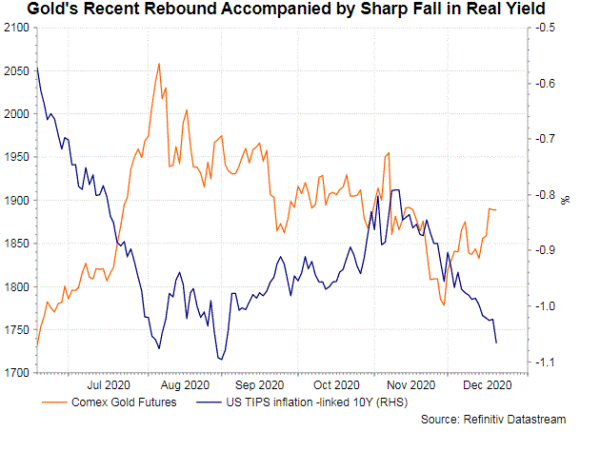Gold’s rebound late November has continued for a third week. Besides bargain hunting, Fed’s pledge to keep the policy rate low and strengthening in the forward guidance in QE, as well as the latest fiscal package approved by the Congress are the key driving forces supporting the yellow metal.
The US congress has managed to strike a deal on fiscal stimulus before Christmas. Hopefully, the long-awaited deal would give the economy a quick relief. The package, worth of around US$ 900B, is the second largest in US history after the US$ 2.2 trillion Care Acts implemented in March. It includes extra jobless benefits of $300/ week, and a new round of $600 stimulus checks. Meanwhile, the package includes almost $100B in funding to help schools and universities, $25B in federal support for renters, and over $10B for the Supplemental Nutrition Assistance Program. It also involves $2B for small US telecommunications companies to strip Huawei and ZTE equipment from their networks.
Gold price has obviously benefited from the deal, given its inverse relationship with Treasury yields. Running annual deficit by around $ 3 trillion, the indebted government would have to finance the spending via loans, which would mainly be shouldered by the Fed. Prolonged weakness in Treasury yields in turns support gold price.
At the FOMC meeting last week, the Fed pledged to maintain the QE program, buying $120B of Treasury and mortgage-backed securities, “until substantial further progress has been made toward the Committee’s maximum employment and price stability goals”. While an amendment to the forward guidance related to asset purchases had been widely anticipated, subdued inflation outlook suggests that Fed’s tapering of QE could come in later than the market had anticipated. Moreover, the Fed’s shift to average inflation targeting suggests that it would leave the current monetary stimulus unchanged until inflation not only reaches 2%, but is “on track to moderately exceed 2% for some time. The latest FOMC economic projection indicates that inflation will not reach 2% at least until 2023, suggesting the policy rate will remain unchanged by then, contrary to what has been suggested by the median dot plot. Keeping the policy rate at the effective lower bound and QE unchanged for an extended period should lend support to gold, again given the promising inverse correlation between the yellow metal and yields.














